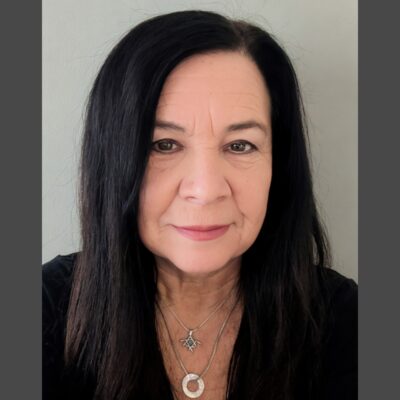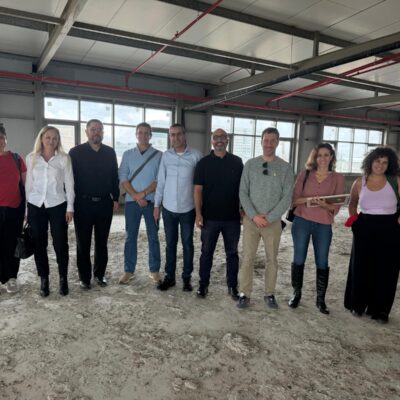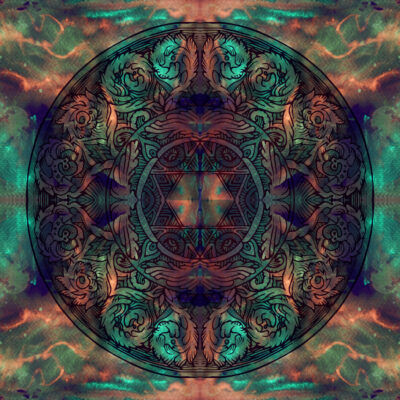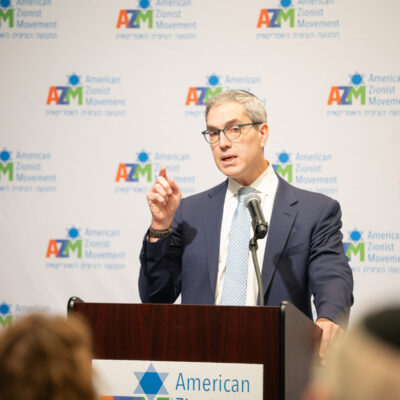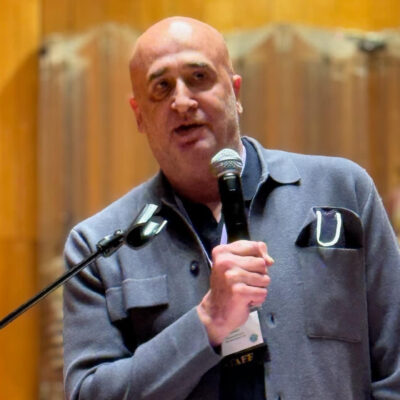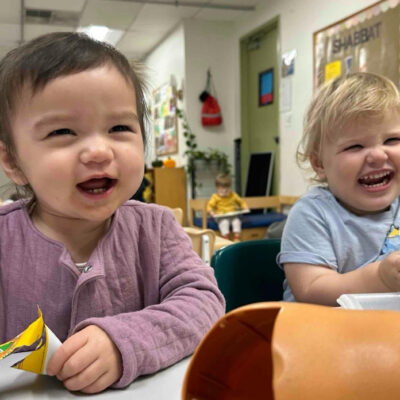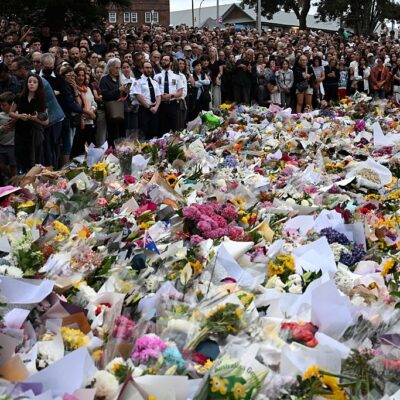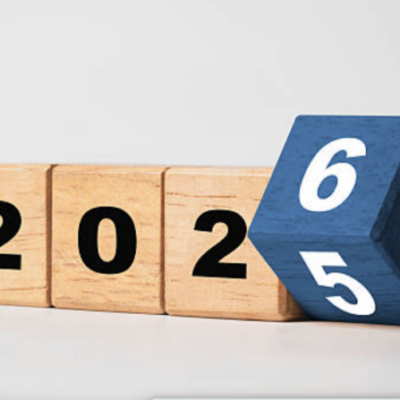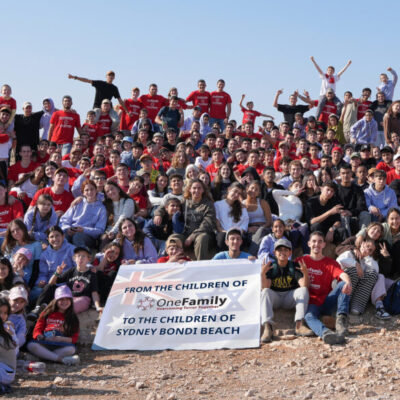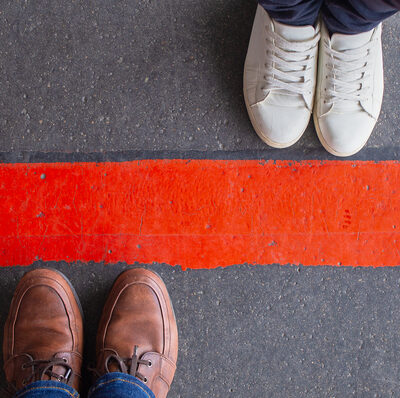Q&A
After quietly supporting Gaza relief work since early 2024, IsraAid CEO opens up and warns: ‘We are reaching an extreme humanitarian situation’
Yotam Polizer says he was at first nervous to operate in Gaza while also helping Israeli communities hit in the Hamas attacks, but the leaders of those communities 'told us that this is the most hopeful thing they heard since Oct. 7'
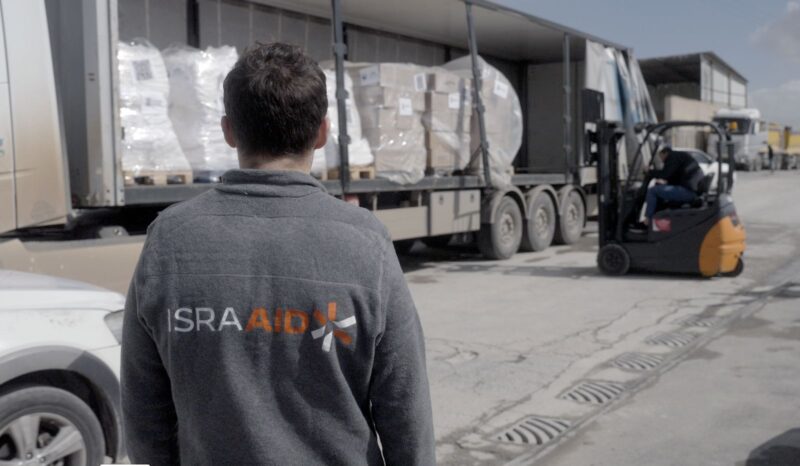
Courtesy/IsraAid
An IsraAid employee watches aid being delivered to Palestinians in the Gaza Strip, in an undated photograph.
For over a year and a half, the Israeli humanitarian relief group IsraAid has been quietly providing assistance to Palestinians in the Gaza Strip, first by serving as an adviser and go-between, helping international aid organizations coordinate with the Israeli government and military. In recent months, this has increased to more direct assistance by creating a logistics hub for partners on the ground.
Until now, IsraAid has not publicized its work in Gaza — though its partners there, its supporters around the world and the Israeli communities it has been helping since the Oct. 7 terror attacks have been aware of its involvement. But as the debate around the humanitarian crisis in Gaza has grown increasingly “toxic” and as the situation there has grown increasingly dire, IsraAid CEO Yotam Polizer told eJewishPhilanthropy that he felt it was time to open up.
Polizer sat down with eJP last week to discuss his organization’s efforts in Gaza, the indications that this is a true humanitarian crisis and how the Jewish world is increasingly getting involved in the Strip.
The interview has been lightly edited for clarity.
Judah Ari Gross: So let’s start from the beginning. How did IsraAid start getting involved with providing humanitarian aid to Palestinians in Gaza?
Yotam Polizer: On Oct. 8, we launched our massive response — our largest response to date, a $20 million operation in sixteen communities in Israel in the south — and that’s been our focus. And when we were watching the situation in Gaza unfolding, honestly, I didn’t think that we could get involved for obvious reasons, right? We’re called IsraAid. It’s pretty clear where we’re from. We don’t want to put anyone at risk from our team or anyone from our partners who will be able to work with us.
Also, IsraAid is always boots on the ground. We work directly with communities. So it was clear that in Gaza we will not be able to be boots on the ground. So honestly, I didn’t think we can get involved and I was not planning to.
But a couple of months later, I think in February-March 2024, we were starting to receive calls from many of our humanitarian partners, organizations that worked with us in Afghanistan, in Ukraine and elsewhere. And they were really struggling to bring in aid into Gaza. And they told us, “Guys, you’re in the middle of it. You’re Israeli, so you know the Israeli system, you know the Israeli authorities, you know how Israel works, you know how to navigate the Israeli system, but you’re also humanitarian, so you understand how the humanitarian system works. So you guys basically have a very unique positioning that no one else has in this crisis.”
At the beginning, I was very hesitant, but then I realized that, because of our Israeli identity, we can actually bring a huge impact to many of these organizations and solve a lot of the problems.
And these organizations were calling us with different problems. They were telling us, “We have this truck that’s stuck somewhere, we need to get the approvals,” or “We have this ship, we need to get the customs clearance,” or “We want to buy some medicine in Israel, but we need someone who knows how to work with Israeli suppliers.” So it was really a very wide range of issues, but all of it was related to access, how to bring aid into Gaza in a way that’s safe, in a way that’s smooth, that’s efficient. So that’s what we started to do. We started to serve as sort of this very quiet facilitator between Israel and the humanitarian community, our office sort of turned into a control room, if you will, or a facilitation room where organizations would come in, representative of the Israeli authorities, especially the [military’s Coordinator of Government Activities in the Territories], which is the main unit that’s coordinating everything with Gaza. And the goal was very simple: to solve problems, to bring in more aid to the people, and to make sure that it doesn’t reach Hamas.
I think what people don’t understand, when they think about Gaza, they don’t understand how different it is than anywhere else in the world. We worked in Afghanistan, we worked in Ukraine, we worked in Iraq, we worked in Syria. What makes Gaza so different? The fact that the civilian population and the active fighting are actually happening in the same place, in the same condensed area. In the case of Ukraine, for example, you have the war zone, the active fighting, which is mostly in the eastern border, but most of the population has fled. They went to Poland, they went to Western Ukraine, they fled for safety. … In the case of Gaza, people can’t leave… and that’s what makes it so difficult to balance between Israel’s security concerns and the humanitarian needs. … And there’s no magic solution to this balance.
JAG: What’s the significance of that for humanitarian aid work?
YP: We’ve all seen that in Gaza, there was a lot of fighting around Hamas-run hospitals, right? So there was a need to create new medical facilities for the people in Gaza, and that could be done by creating field hospitals. There are organizations that know how to build field hospitals, but in order to build the field hospitals, you need to bring a lot of supplies from outside, including items that are considered “dual use.” What is “dual use”? “Dual use” are items that could be used for explosives in the wrong hands. The most obvious example that I use always is an oxygen concentrator, but quite frankly, almost every medical device could become dual-use. So how do you balance that? How do you make sure that it doesn’t fall into the wrong hands and that people who need it will get their medical treatment?
We make sure that the area that is chosen for the field hospital is deconflicted. We make sure the routes leading there are deconflicted. We make sure there’s no active fighting anywhere near. We make sure the IDF is scanning all these items. That’s the kind of work that you need to do in order to make sure the civilian population gets the aid they need and that the IDF is vetting and monitoring and making sure it doesn’t reach the wrong hands. So that’s the kind of work we’ve been doing.
JAG: And how has that changed over time?
YP: After a few months of doing this very quiet coordination and facilitation and helping both sides understand each other and speak to each other, we realized that we needed to do more because we were watching how the humanitarian situation was deteriorating. We decided to establish a logistics hub and support vetted and trusted partners.
So we would procure medicine for them. We would get funding to bring in doctors and nurses. We would help them with customs clearances. We would help them with storage and transportation, everything they need, and we would get it to the border.
JAG: The obvious question is how you ensure that this aid and assistance doesn’t make its way to Hamas or other terrorist groups.
YP: Honestly, there’s no perfect solution in such a condensed war area, where Hamas is embedded within the population. But what we do know works better than anything else is close coordination and communication. And it goes back to the vetting process, making sure basically that all of these partners do not have team members affiliated with Hamas, making sure that everything they bring is scanned properly.
Also, Israeli policies have changed during this war. In the beginning, the declared policy of the government was that nothing would come in from Israel. And then Israel opened its crossings, and now the preferred route is to bring aid from Israel into Gaza.
At some point, we also realized that we should work on a higher level, too. During the ceasefire [in January and February], Israel agreed to allow 600 trucks into Gaza each day. And I remember, we worked in close coordination with the IDF to make that happen together with the U.N. and the many other aid organizations. And I know we all hear about the toxic relationship between Israel and the U.N., but I can tell that I saw that it was a very productive collaboration on that mission.
And by the way, that was important for two reasons. One is to address the needs in Gaza, but the other one is to make sure that Israel complies with the deal, and we will see our hostages. Our office is across the street from Hostages Square, literally across the street. And I remember every week, when the hostages were released, I could actually hear it. I could hear the relief, people were able to breathe for the first time when we saw our hostages released. So I felt our mission had a double meaning and double impact, both to the people of Gaza and to the families of the hostages.
JAG: And then the ceasefire fell apart.
YP: So we still have fifty hostages in Gaza, which is heartbreaking, and especially after seeing these images this past weekend and seeing the level of desperation and the state that they are in.
And then, in mid-May, the Gaza Humanitarian Foundation (GHF) was introduced. I don’t need to get too much into the GHF. A lot has been said about it. I can tell you that we are not part of the GHF, not formally or informally. We did meet with them as we are meeting with everyone. We’re trying to see how we can help improve these mechanisms and how we can also create a parallel mechanism between GHF and the more traditional humanitarian actors, the U.N. and the NGOs, because what we understand is that the only way forward is if we all work on this together.
And the thing about GHF, and again, I’m not trying to get into the toxic conversation about it, but what was clear from the beginning — and that was clear not just to me or the U.N., it was clear to the GHF people themselves — is that they will not be able to provide food for the whole population. They only launched four sites, three in southern Gaza and one in the center. In the best-case scenario, it could reach half of the population. So it was very clear to everyone that we need this parallel mechanism and that we can’t just count on the GHF to provide for the whole population.
Also, a big concern for us is that we need to reach the most vulnerable. It’s hard, especially for the elderly, disabled people, young children, to go to the GHF sites. So we need to find a way to address this.
Both people receiving aid and aid workers need to feel safe — the first rule of humanitarian aid is “Do no harm.”
JAG: What is the situation like in Gaza today?
YP: I’m not getting into the scientific terms of this or that [about what constitutes starvation or famine]. These are scientific terms. If we are at this level of starvation or famine, I’m not getting into it. But what we do know is that the situation is quite extreme. We can see that from the steps Israeli authorities have taken in the last few weeks to ramp up aid delivery. And, especially in northern Gaza, because there was a big deficit of aid and food aid specifically, for quite a few months, we are reaching the point of an extreme humanitarian situation. That’s why right now we’re focused on getting as much essential aid as we can — food, medical support, hygiene supplies — to people in need, as urgently as we can.
At the moment, we really believe that the only way forward is if we get everyone involved, and I mean everyone, I mean the Israeli government, the IDF, the U.N., the GHF, the NGOs, the Gulf countries — I think the UAE is actually playing a very important role in aiding Gaza and they want to play an even bigger role.
We are already seeing a change in policy. About two weeks ago, the prime minister declared that more aid will be allowed in from multiple directions, including airdrops, including more from crossings, including coming from Egypt and Jordan. And I think that’s very important. And I think we need to make sure that it’s consistent.
In the absence of a hostage deal now, it’s very, very important to see that the aid is consistent and that we can avoid a bigger catastrophe from a humanitarian perspective.
JAG: You said that IsraAid doesn’t have a team on the ground in Gaza. Have you, personally, been able to go? Have you seen the situation in Gaza?
YP: I cannot go into Gaza.
JAG: As you said, there’s a certain toxicity around the topic of humanitarian aid. There have been patently bad practices in the media of using misleading photographs, but then on the flipside, there is outright denial that there is a humanitarian crisis in Gaza. Since you have not been able to go in personally, from your partners on the ground, what are some of the specific indicators that are showing that this is a real, true humanitarian crisis?
YP: The reason we know that this is real is because we’re hearing that from a lot of partners whom you can’t accuse of being pro-Hamas or being affiliated with Hamas, whether it’s vetted partners and organizations, whether it’s Palestinians who have been involved in protests against Hamas, or whether it’s a Hebrew University professor who has been researching for a long time the ups and downs in the prices of flour in Gaza. When it reaches $2,000 per 25 kilograms (55 pounds) of flour, you know the crisis is real, and you know the scarcity is real.
But I’m also being very cautious with giving it scientific terms here and there. We know that the crisis, especially in northern Gaza, but also in southern Gaza, is quite extreme.
I think something that is very important to think about when we think about the food prices is that when people reach severe malnutrition, just giving them more rice or flour is not going to do it. They will need nutritional supplements. They will need medical intervention in some cases. So we also need to think about that, and that’s a big focus for us now.
One thing that I think is also very important and something that we’re looking at right now is joining different partners who are supporting orphans in Gaza, orphans who lost their parents during this war. I’ve heard from a Palestinian partner that I can’t name that a lot of the Gazan children who lost their parents are being recruited by Hamas and other [terrorist] organizations. And so I think supporting orphans, making sure that they have a future in Gaza, should be one of our top interests. A. Because it’s the right thing to do and it’s the humanitarian thing to do; and B. Because it’s what will help all of us be safe and will prevent a future Oct. 7.
JAG: Along those lines, when you’re operating your logistics hub and when you’re operating in Gaza, I assume you’re not doing it with the IsraAid logo. Is there understanding among Palestinians that this is something that Jews in general and Israelis in particular are involved with?
YP: We work with 12 different organizations right now. They all have many Palestinian staff, so we communicate with them on a daily basis. We have Palestinian staff in Israel who are working on this. So we can communicate with them directly in Arabic, and they are very much aware [that they are working with an Israeli organization]. We’re not putting our logos on anything. We have zero visibility because we just don’t want to put anyone at risk right now. But the people who work with us know very well, including many in the international community, including the U.N. and different NGOs.
Our approach until now was: We can’t share this story publicly, but we want to make sure the right people know. I’ve also done many briefings and meetings with heads of humanitarian organizations in the U.S. Just last week, I was in Washington and in the U.N. and elsewhere. So I think there’s wide recognition for the importance of our role and I hope we will be able to do more.
JAG: As eJP has reported, IsraAid has been operating in Israel since the Oct. 7 attacks. What is it like now working on both sides of the same conflict?
YP: It was one of the hardest decisions I ever made to get involved in this operation. Oct. 7 was very, very personal for me and for us as an organization. And we work with those communities [that were attacked]. But I want to tell you that one of the things that helped me decide to get into this project was just when we started to get involved, I was worried what the people of the otef [the Gaza border area] would think, what the people who went through the Hamas massacre would think.
We have such a deep relationship with them. So I actually went and spoke to the heads of these communities and told them what we’re doing. We’ve been doing things very quietly until now [in Gaza], but things could easily leak and we wanted to make sure that [they heard it from us]. And I have to tell you, we received very positive responses. And I can tell you that some of these community leaders told us that this is the most hopeful thing they heard since Oct. 7 because they understand that we’re thinking not just about people on the other side, we’re thinking of their future and their safety and how important it is to to support civilian population also on the other side of the border. And that’s what makes us who we are. We have to practice what we preach.
And we are now speaking out for the first time because: A. We believe the situation has gotten so bad and that there’s also so much misinformation, and it’s important to provide a factual, professional humanitarian assessment. B. It’s also important for people to know what they can actually do. I think so many people, everywhere, but especially in the Jewish community, feel so helpless about the situation. They don’t know what could be done. And I feel very strongly that Israeli civil society, the Jewish community, should be part of the solution, should take a leading role in supporting communities [in Gaza], not just now, but also in the day after.
We also wanted to make sure that we can tell the story, the real story from our perspective, because there are so many sound bites, there are so many toxic media communications and messages on all sides. And I think really the source of everything is, of course, the trauma of Oct. 7 on the Israeli and Jewish side, but also on the Palestinian side. And that’s leading to a lot of dehumanization. And for us as a humanitarian organization that’s been working in 64 countries around the world, humanizing this situation, understanding how we can support the children, the women, the disabled, the elderly, that is what makes us who we are.
JAG: The weaponization of humanitarian aid in Gaza has been going on for a long time now, well before the start of the current war — Hamas appropriating aid coming into Gaza, stealing concrete to build tunnels, taking food for its fighters. And now, you have Israel and the United States using the leverage of humanitarian aid by trying to create an alternative system through GHF. As a humanitarian organization, what is it like operating in a situation where both sides is trying to use aid to advance its war effort?
YP: Our approach is extreme pragmatism. We want to find solutions. We want to be able to deliver the aid to the people right now. And we work with everyone who will work with us on that, including the [Israeli] government, including the IDF. We have to coordinate with them.
There are real humanitarian needs. And that also should be clearly, clearly recognized and clearly acknowledged, and I think it has been — with a few exceptions. So that’s why I’m taking this pragmatic approach, because I don’t think enough people are taking this pragmatic approach right now. And people don’t talk to each other. And we’re probably the only organization that right now speaks to everyone, all the actors involved. And trying to get everyone to work together and share the same goal.
In the last ceasefire, we had the goal of delivering aid into Gaza and to release our hostages. And that was a goal that was shared between the Israeli authorities and the humanitarian community. And that’s how we were able to achieve a lot. So when we work together on these common goals, we could really make huge progress.
While there is active fighting, in the absence of a permanent ceasefire, it’s always going to be extremely challenging. And everything we do right now is a drop in the ocean and is putting a Band-Aid on a bullet wound, but I do think that building this relationship, building this trust and having this kind of successful pilot first, it saves lives. Period. And it also creates the infrastructure for future collaboration, which is again just the only way forward for the region.
JAG: IsraAid generally sticks around in the areas where it provides humanitarian aid. It’s normally not a one-off drop and you’re on your way. Are you already having those long-term discussions about Gaza reconstruction?
YP: So we so we’ll have to keep our flexibility, but we’re in this for the long run. We understand the needs that are going to be there for the long term. Even if Hamas will be gone tomorrow and the war is over and the hostages are out, which is something that we wish for, the long-term recovery and rebuilding will take years.
And similar to our work in Ukraine, similar to our work with Syrian refugees, we will be in there for the long run, for years.
I think that the good news is that we are seeing more partners coming in now from the Jewish community, and I’m actually really heartened by that. Major synagogues, federations, big institutions are stepping up. [Ed. note: UJA-Federation of New York recently announced that it has allocated $1 million for IsraAid’s Gaza work.] They want to get involved. And I think that IsraAid provides them with a very safe and trusted way to join in, whether it’s by donating or whether it’s by advocating or introducing us or helping us with partnerships. So we really hope to be sort of the go-to for the Jewish community, for Israeli civil society.
There are already quite a few Israeli organizations [operating in Gaza]. I know [eJP] has interviewed some of them, like the Arava Institute and a few others, that are already involved in this effort. We think there’s more that will get involved. There are some Israeli hospitals that have reached out to us. I can’t name them, but they reached out to us. They want to be able to help. Maybe they can help with remote medicine. I do imagine a day when we will be able to bring our team into Gaza. It may take a while. It may take a while. But I’m really hoping it will happen sooner rather than later.
And then I’m thinking about the Israeli Arab community. And so many medical professionals that we have here in Israel, 40% of the medical professionals in Israel are Arab Israeli. They could be such a huge asset to support the medical system in Gaza. And that would be good for everyone, right? But we need to get to a place where there’s more stability, and then I think we’ll be able to do much more.
So yes, we’re already deep in this. We are raising $10 million. We have already spent more than $4 million on the different programs that we’re doing. But for me, it’s just scratching the surface and building the infrastructure for something much bigger.
And I will give you a hint that we’re also looking at it from a regional perspective, not just in Gaza. We are also looking at establishing a regional work and support the recovery in other places. We just launched a program to support the Druze in Syria. We are looking into other countries in the region. I can’t share where yet, but I do think that Israel and Israelis should be a force for good in the region, and the region is suffering from so much.
And you mentioned how toxic just the words “humanitarian aid” became. And it should be the opposite. It should be what brings us together. It should be what brings humanity together. So that’s sort of the vision that I have for the recovery and healing of the nation. We’re still working in Israel, and we’re working now more with hostage families to help them recover. We’re still working in the north. We’re still finalizing our project in the south. So that’s also not going anywhere.
JAG: You said that you are now speaking publicly about this issue because the situation in Gaza is getting more dire and to counter misinformation. As we’ve documented in eJP, there seems to be a shift more broadly in the Jewish community in recent weeks about the humanitarian situation in Gaza, has that been a factor at all for you? Are your funders and Jewish partners more comfortable getting involved in this area?
YP: There was change. It’s changing in Israel too right now. There’s still a lot of so much pain on the Israeli side and also on the Jewish side. First and foremost, because of the hostages. Second, because of a lot of the rise in antisemitism that people are experiencing around the world. So I think the pain is still very much there.
But in the last few weeks, we see a change, and I think there’s more acknowledgement from almost everyone — not everyone, it’s never everyone — but almost everyone about the level of the crisis. And people are more ready to take action, to get involved.
I’m not here to criticize anyone who is not yet ready to jump in and support [humanitarian aid work in Gaza], but I think I see it from the mainstream Jewish community, and more and more parts of the mainstream in Israel. We still have a long way to go, but we’re seeing much more coverage of the humanitarian crisis in Gaza in the mainstream media here in Israel, not just in Haretz.
And again, it’s partially because the situation [in Gaza] has gotten to a new low, but also I think it’s that people are very frustrated [that the war in Gaza is continuing]. People understand that they need to find a way to step up, and they understand that we can’t ignore this.

 Add EJP on Google
Add EJP on Google

